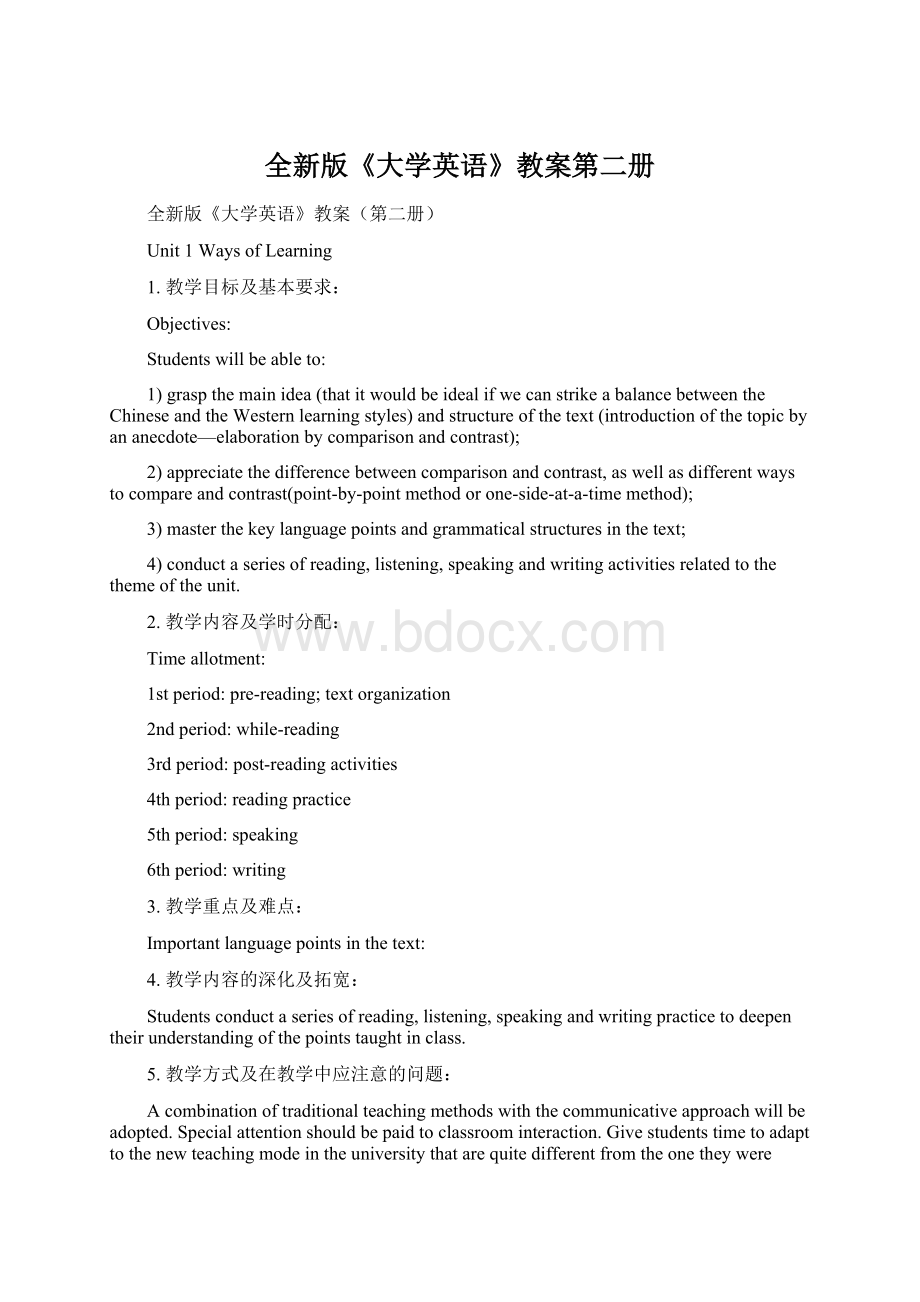全新版《大学英语》教案第二册Word格式文档下载.docx
《全新版《大学英语》教案第二册Word格式文档下载.docx》由会员分享,可在线阅读,更多相关《全新版《大学英语》教案第二册Word格式文档下载.docx(15页珍藏版)》请在冰豆网上搜索。

while-reading
3rdperiod:
post-readingactivities
4thperiod:
readingpractice
5thperiod:
speaking
6thperiod:
writing
3.教学重点及难点:
Importantlanguagepointsinthetext:
4.教学内容的深化及拓宽:
Studentsconductaseriesofreading,listening,speakingandwritingpracticetodeepentheirunderstandingofthepointstaughtinclass.
5.教学方式及在教学中应注意的问题:
Acombinationoftraditionalteachingmethodswiththecommunicativeapproachwillbeadopted.Specialattentionshouldbepaidtoclassroominteraction.Givestudentstimetoadapttothenewteachingmodeintheuniversitythatarequitedifferentfromtheonetheywereusedtointhemiddleschool.Moreencouragementisneededandmoreguidancewillbegiventothemintheirextracurricularstudy.
6.主要参考书目:
季佩英,吴晓真,2001,《全新版大学英语综合教程2-教师用书》。
上海:
上海外语教育出版社。
柯彦玢,张砚秋,2002,《全新版大学英语阅读教程2-教师用书》。
朱万忠,2002,《大学英语阅读进阶2》。
重庆:
重庆大学出版社。
7.思考题和习题:
《全新版大学英语综合教程2》第一单元TextA后的所有习题。
阅读第一单元TextB,完成后面的相关练习。
《全新版大学英语阅读教程2》第一单元及相关练习。
《大学英语阅读进阶》第一单元及相关练习
WritingAssignment
1stperiod
1.MakingSsinformedofthedifferentrequirementsofCollegeEnglishascomparedwithMiddleSchoolEnglishandthecourseplanofthisterm.
2.T-Sinteractiontogettoknoweachother.
Thefirsthalfofclass:
1)Ts’openingremarks
2)Ts’deliveringhandoutofCoursePlantoSsandelaboratingit.
Thesecondhalfofclass:
AskSstointerviewtwootherSsandfillinthetable.
Questions
S1
S2
Name
Interests
Whereyoulive
StrengthsinEnglish
WeaknessesinEnglish
WhatEnglishlanguageskillsyouneedthemostinyourfuturelife
WhatyouthinkyourbiggestchallengewillbeinEnglish
WhatkindofEnglishteacheryoulike
Thegoalyou’dliketoachieveinEnglishlearning
WhyyouchooseCQU
2ndperiod
IntegratedEnglish(4periods)
1)Graspthemailideaandstructureofthetext;
2)Appreciatethedifferencebetweencomparisonandcontrast,aswellasdifferentwaystocompareandcontrast;
3)Masterkeylanguagepointsandgrammaticalstructuresinthetext;
4)Conductreading,speakingandwritingactivitiesrelatedtothethemeoftheunit.
TheFocusanddifficultpoints:
1.ThemainideaandstructureofTextA.
2.TheunderstandingoftextAincludingsomedifficultexpressions.
3.Thefollow-upactivity:
debateoneducation(Shouldwedevelopchildren’screativityfirstortraintheminbasicskillsfirst?
)
TimeAllocationandCourseArrangement:
Pre-readingTasks:
(30minutes)
1.DeliverhandoutonAmericaneducationandaskSstoskimformainideaandmainfacts.(5’)
2.Pairwork:
brieflytalkaboutthefeaturesofAmericaneducationbasedonthehandout.(15’)
3.Askseveralpairstoreporttheirdiscussion.(10’)
4.T’sfeedback.(5’)
While-readingTasks:
(60min)
1.AskSstoskimPara1--5anddopairworktoanswerthefollowingquestions:
(25’)
1)Whereandwhendidtheincidenttakeplace?
2)Whoarethemaincharactersinthisincident?
3)WhatistheattitudeoftheauthorandhiswifetowardBenjamin’seffortsininsertingthekeyintotheslot?
4)WhatistheattitudeofthehotelstafftowardBenjamin’sefforts?
2.Tintroduceswaysofintroducingatopic(writingstrategy1).
3.AskSstounderlinethefollowingexpressionsinyourbooks:
beattachedto
//
position//notintheleast//findone’swayto//phenomenon-phenomena//initial//assist//await//onoccasion//neglect//berelevantto//
4.AskSstoskimPara6-10anddiscussthefollowingquestions:
1)Whatdoestheauthormeanbysayingthisincidentwaskeyinmorethanonesense?
2)HowdoAmericansandChinesedifferintheirattitudestocreativity?
3)Whatsuggestionismadeaboutseekingabetterwayforfosteringskillsandcreativity?
5.Tintroducescomparisonandcontrast(writingstrategy2).
6.AskSstounderlinethefollowingexpressionsinyourbooks:
exception//ultimate//onone’sown//accomplish//proceedto//induecourse//critical//principal//childrearing//makeupfor//figureout//inretrospect//cometosb’srescue//extreme//facility//mold//shape//somuchsothat//continual//apply//workon
7.AskSstosummarizethemainideaandstructureofthetext.(10’)
Homework:
1.DeliverhandoutsaboutlanguagepointsandaskSstoreviewthemafterclass.
2.Finishexercisesofunit1.
3.FinishreadingTextB.
4.AskSstosearchonInternetabouteducationandtakenotestopreparethefollow-updiscussiononShouldwedevelopchildren’screativityfirstortraintheminbasicskillsfirst.
After-readingTasks:
(90min)
1.BasedontheinformationsearchedonInternet,SsholdgroupdiscussiononthetopicShouldwedevelopchildren’screativityfirstortraintheminbasicskillsfirst.(15’)
2.Theclassisdividedintotwogroupsbasedondifferentideasanddebateonthetopic.(30’)
3.TwoSsrepresenteachsidetosummarizetheirideas.(15’)
4.CheckonTextBandexercises.(30’)
SpeakingCourse(twoperiods)
1.FamiliarizeSswithvocabularyonsportsanddiscussconcernedtopics.
2.FamiliarizeSswithvocabularyonweatheranddiscussconcernedtopics.
CourseArrangement:
1.DeliverhandoutonexpressionsofsportsandfamiliarizeSswithvocabularyonsports.(10’)
2.Conductgroupdiscussionbasedonquestions:
(20min)
A.Doyoulikesports?
Whatareyourfavoritesports?
B.Whydopeopleneedtoplaysports?
C.WhatdoyouknowaboutOlympicGames?
3.Groupleadersreporttotheclass.(15’)
1.DeliverhandoutonexpressionsofweatherandfamiliarizeSswithvocabularyonweather.(10’)
2.LeadersofeachgroupcasuallypickoutascripfromTswithtwoquestionsonitanddiscussthequestions.(20’)
—What’syourfavoriteseasonandwhy?
—Arethereanyspecialtraditionsassociatedwithdifferentseasoninyourcountry?
—Whatcropsareproducedinwhichseasonsinyourcountry?
—Doyouthinkweatherpatternsarechanging?
Ifso,whydoyouthinkthisis?
—Doyouhavesnowinyourcountry?
(Doyouhavehail?
)Describeit.
—Doyouthinkthatinrecentyearswearelosingourfourdistinctseasons?
—Whatkindofclimatedoyoupreferwhenchoosingaplacetogoonvacation?
—Inyouropinion,whichseasonisthemostbeautiful?
—Areyouconcernedwithweather?
Howdoyougetweatherinformation?
—Doyouliketheclimateofthecitywhereyoulive?
Whyorwhynot?
—Isweatherforecastingimportantinmodernlife?
—Whichdoyoulikebetter,hotweatherorcoldweather?
—Doyouthinkitispossibleorimpossibletogiveaccurateweatherforecast?
Why?
—Trytotellyourclassmateswhattheweatherislikeatthismoment.
—Doyouthinkweatherwillinfluencepeople’smood?
How?
—Whichplacearoundtheworlddoyouthinkhasthebestorworstweathercondition?
Describeit.
3.Groupsecretaryreportstotheclass.(15’)
CulturalNotes
1.EducationintheWest:
ThereisnocommonagreementintheWestconcerningthebestmethodofeducation.Avarietyofviewscanbefoundamongparents,teachersandstudents.Indeed,it
mightbearguedthatilisthisveryexistenceofcontendingpointsofviewthatischaracteristicofWesterneducation.ThiscanbeseenasfarbackasintheworkoftheancientGreekphilosopherSocrates,whoencouragedhisstudentstoquestioneverything,eventheirmostfundamentalbeliefs.Yeteventhentherewasnogeneralagreementthatthiswasthebestwaytoteach.Socrates,afterall,wascondemnedtodeathbyhisfellowcitizensforcorruptingthemoralsoftheyoungbyhiswayofteaching.ManylaterperiodsofWesternhistorywerenomoretolerantofencouragingstudentstochallengetraditionalbeliefs:
Darwin'
stheoryofevolution,forexample,wasforatimebannedfromschoolsinsomeAmericanstatesonthegroundsofreligiousbelief.
Muchofthecurrentdebateovereducationsurroundstheextenttowhichlearningshouldbeteacher-basedorstudent-based.Whichofthetwoshoulddecidewhatshouldbelearned,howitshouldbelearned,andwhenitshouldbelearned?
ComparingWesternandAsianmethodsoflearningitisgenerallytruethatWesternmethodsaremorestudent-centred,expectingstudentstodiscoverthingsforthemselvesratherthanrelyingontheirteacherstotellthem.Anextremeversionofthestudent-centredapproachcanbeseenatSummerhill,aschoolinEnglandestab-'
lishedbytheeducationalistA.S.Neill.Therechildrenhavecompletefreedomtodecidewhattheyaregoingtolearnandwhichlessonstheywillattend.Iftheywishtheyneednotattendanyatall.MainstreameducationinEnglandisfarmorestrict,demandingthatchildrenattendlessonsandfollowanationalcurriculum.Thiscurriculumandtheimportanceofachievinggoodexamresults.tendtoreinforceamoreteacher-centredapproach,asbothteachersandstudentsfindthepressureoftimeleaveslessopportunityforan